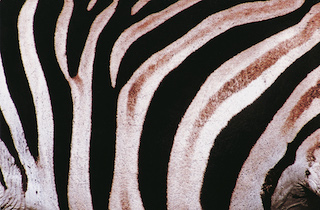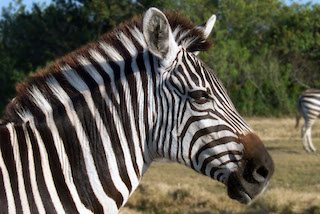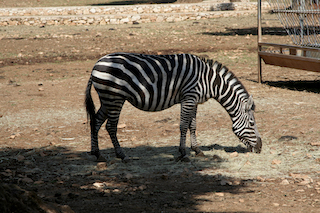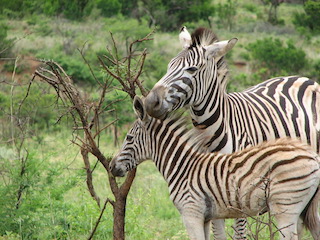3 Species Of Zebras
1) Grevy zebra
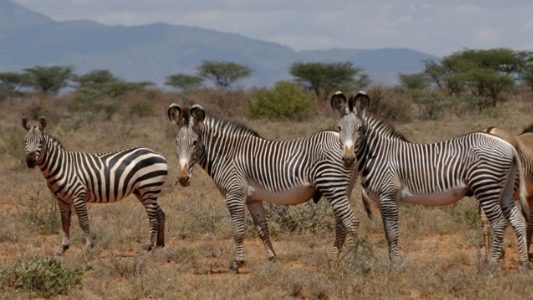
3 Species of zebras
In 1882, the then Emperor of Abyssinia considered zebra so regal that he presented a zebra to the President of France whose name was Jules Grevy. This led to the coining of the word Grevy zebra. It is the most beautiful of zebras. The pattern of its hide is like a painting. The World conservation union lists them as an endangered species. Grevy zebra has an open society where other males are tolerated within the area as long as they don’t interfere with the dominant male’s breeding activities. The 2 most stable relationships they have are a mare’s attachment to its young and a stallion’s attachment to his territory. The lifespan of Grevy zebra is longer in captivity than it is in the wild.
Habitat
Grevy zebras are predominantly grazers and occasional browsers. They can eat tough grasses that are inedible to other ungulates. Sometimes you find them grazing side by side with cattle. They are also seen with a herd of antelopes.
Herds
Grevy zebras don’t form permanent herds. Associations only last for a few weeks or even just days. Zebras have the largest areas of all living herbivores, up to 10 square kilometers. They mark the borders of these boundaries with piles and heaps of dung.
Birth
Females tend to conceive every 2 years. Births usually happen with the onset of rains i.e. May to June as well as November to December. Pregnant females isolate themselves from the herd as birth approaches. Birth takes place lying down. The foal is born all ears and legs after 13 months inside its mother. The young’s hooves appear 1st with a full appearance in 8 minutes. The foal then frees itself from the amniotic membranes. It then crawls towards the mother’s head who licks it clean. The ritual is important in initiating maternal bond. Foals can stand after 6 minutes and run after 45 minutes. At the time of birth, foals weigh around 80 to 125 pounds.
Decimation
In the olden days, it was easy to find Grevy zebras where permanent water was available in the semi-arid grasslands or acacia savannas throughout Ethiopia, Eritrea, Djibouti, Somalia and Kenya. But not anymore. Today it is almost exclusively found only in northern and central Kenya as well as in north-eastern Ethiopia. In the 1970s, there were around 15,000 of them in Kenya alone. In Ethiopia, the current population of Grevy zebra has decreased from 1,900 in the 1980s. It is presumed to be extinct in Somalia because it has not been sighted there since 1973. Having said that, Grevy zebras have flourished in many conservancies where efficient management had catered to both pastoralism and wildlife.
2) Mountain zebra
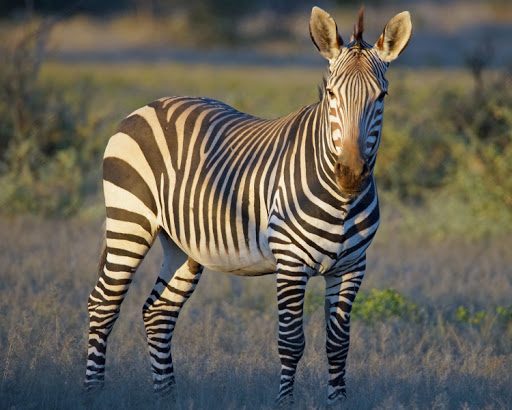
3 Species of zebras
Mountain zebras are mostly active early in the morning and late afternoon until sunset. They visit mineral licks especially during summer. Like other zebra species, mountain zebras are mainly grazers. Their pointed ears reach 8 inches in length. Their manes of short hair stand upright from their necks. Mountain zebras take part in mutual grooming and usually take a dust bath daily. They have 4 single-toed hooves. They have vertical stripes on the torso and neck as well as horizontal ones on the haunches.
Range
Mountain zebras inhabit grasslands as well as rugged mountainous slopes and plateaus. They prefer escarpment areas with a rich diversity of grass and perennial water sources. They are good climbers and have hard hooves apt for climbing steep terrain. Mountain zebras are found in South Africa, Namibia and Angola and are the least common of the species.
Herds
Mountain zebras live in breeding herds consisting of 1 stallion, up to 5 mares and their young. This social structure remains stable over many years. Females usually stay in a pack for life. Surplus males live in non-breeding groups at times including young fillies too. Individuals sometimes establish a new breeding herd. Or they may displace the dominant male to take over its existing herd. New stallions court with females of the herd for up to 3 years before the mares accept them.
Conservation
Mountain zebras are considered vulnerable because they have suffered massive population declines over the past century. Nevertheless, its population is now stabilizing due to concerted conservation efforts at the local, national and international level. Hartmann zebra and Cape zebra are the 2 types of mountain zebra. Both are allopatric, meaning they occupy separate and non-overlapping areas. Some conservationists believe that Hartmann zebra and Cape zebra are different species because of their habitat differentiation. However, genetics prove that they are closely linked.
3) Plains zebra
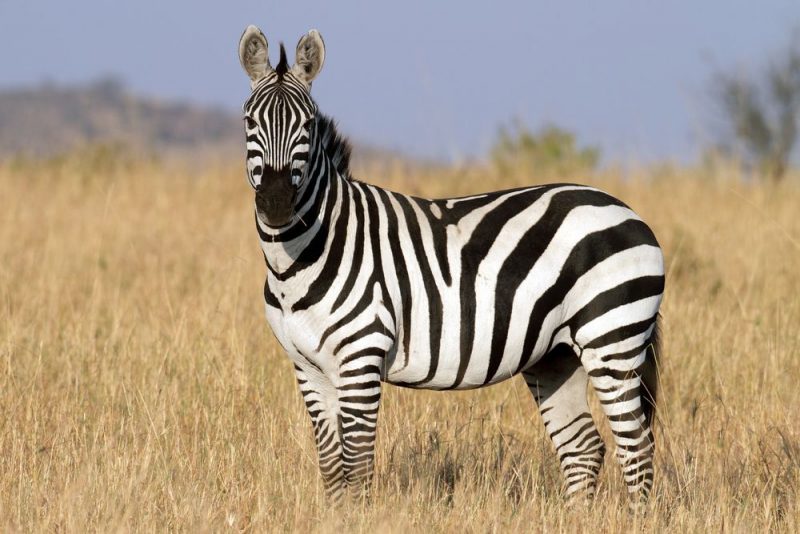
3 Species of zebras
Plains zebra is the most geographically widespread equine on earth. While in some parts they live a sedentary lifestyle, in other regions like Serengeti they migrate in response to the availability of water. Plains zebras are herbivores. They obtain their food by grazing. They feed selectively on certain species of grass. The conspicuous plains zebras are often the 1st to enter and colonize well-vegetated areas of grassland. They can even survive upon coarse vegetation with little nutritional value as a result of a hindgut digestive system. After they trample the grass, the wildebeests and gazelles tend to move in gradually. The removal of such tougher growth of grass from savannas plays an ecological role in allowing other grazers to gain access to tender growth. Due to constant grinding of food, its back teeth continue to grow throughout its life.
Subspecies
Plains zebras exhibit a large degree of diversity. There are 6 separate subspecies. Variations in features between the subspecies include coat patterning, the extent of stripe coverage, the presence of a mane and the body size. The IUCN classifies 5 of the subspecies as least concern. However, the 6th subspecies, quagga, is classified as extinct. They lived in South Africa and was thought to be a separate species due to its unique coloring. They looked like a cross between a zebra and a horse. The last quagga died at a zoo in Amsterdam in 1883. Through a program that has now proven to be very successful, biologists are trying to revive and bring it back from extinction with the use of DNA retrieved from preserved quagga pelts. The most common of the subspecies is Grant’s zebra. Much of what we know about plains zebras comes from work done with Grant’s zebra in the wild and zoos. Chapman zebra is another subspecies occurring in Angola and Namibia. The stripes of this subspecies are absent altogether on the legs.
Range
Plains zebras live in eastern and southern Africa and is the most prevalent in the continent of Africa. The range of plains zebras includes Kruger national park in South Africa, Etosha national park in Namibia, Hwange national park in Zimbabwe, Tsavo and Maasai Mara in Kenya as well as Serengeti national park in Tanzania. Many of them live in protected areas across its range. Plains zebra is incredibly resilient. They appear to be doing well even in some unprotected parts. Plains zebras remain common in game reserves. Its endangerment situation is less alarming than other zebra species. However, they are regionally extinct in Lesotho, Burundi and Angola.
Conservation
Plains zebras are not a threatened or endangered species. The IUCN red list classifies it as a species of least concern with the most stable population. They are relatively widespread. Their numbers once exceeded 750,000. There are an estimated 150,000 plains zebras in Serengeti and Maasai Mara alone. But there are far fewer of them today than before. Like other animals in the wild, plains zebras are susceptible to hunting, habitat loss and poaching. Expanding human settlements is a cause for concern too. Therefore, measures are necessary to guard against the possibility of further reductions.
To receive a colourful digibook about Zebra with videos, images and text, please fill out the following form or simply email us on safaris@safari-center.com


